INSTITUTE OF PHILOSOPHY OF NATURE






Our Book
Volume III - UNIVERSAL MYSTERY UNFOLDED
About this book
Preface
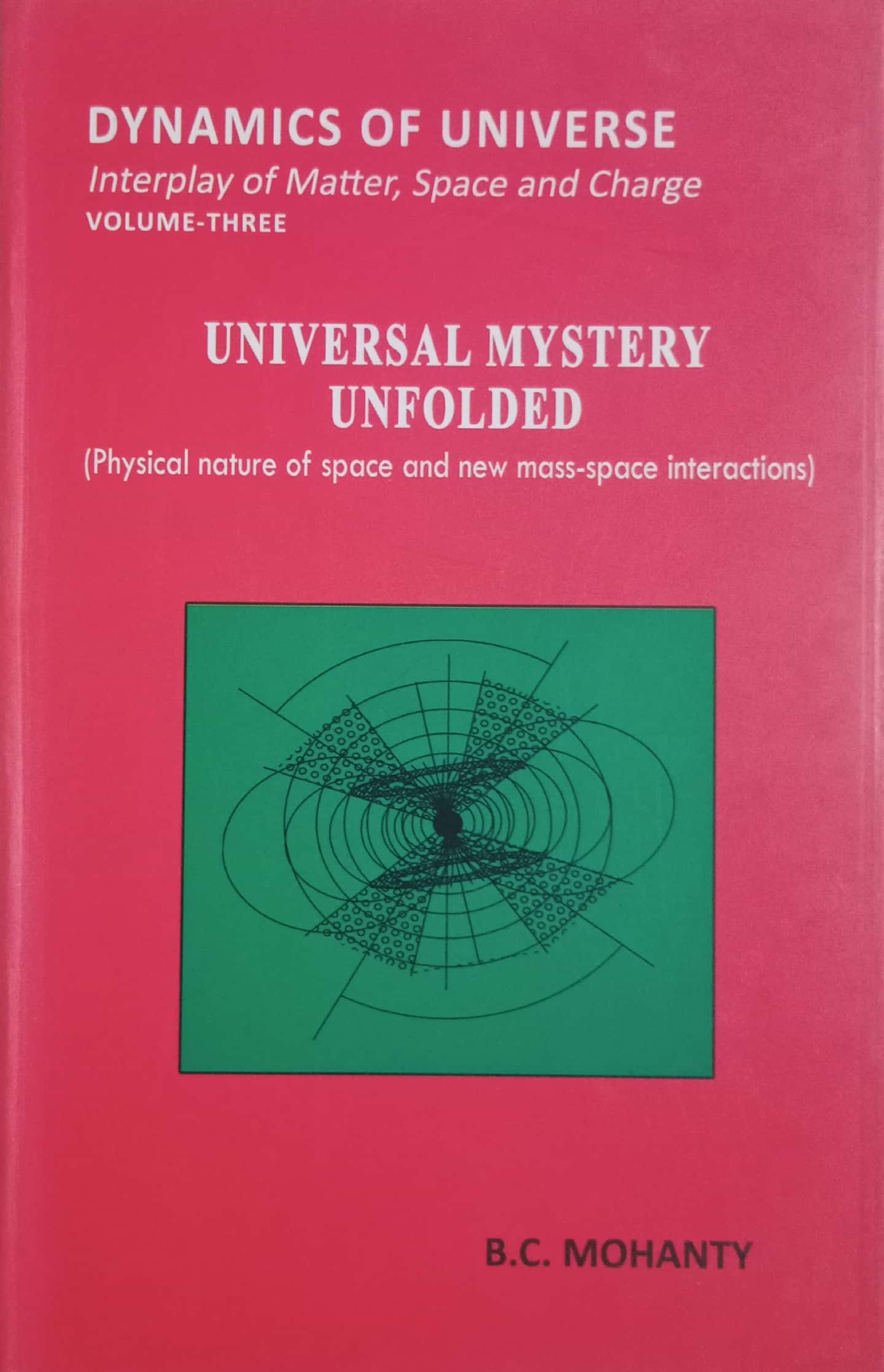
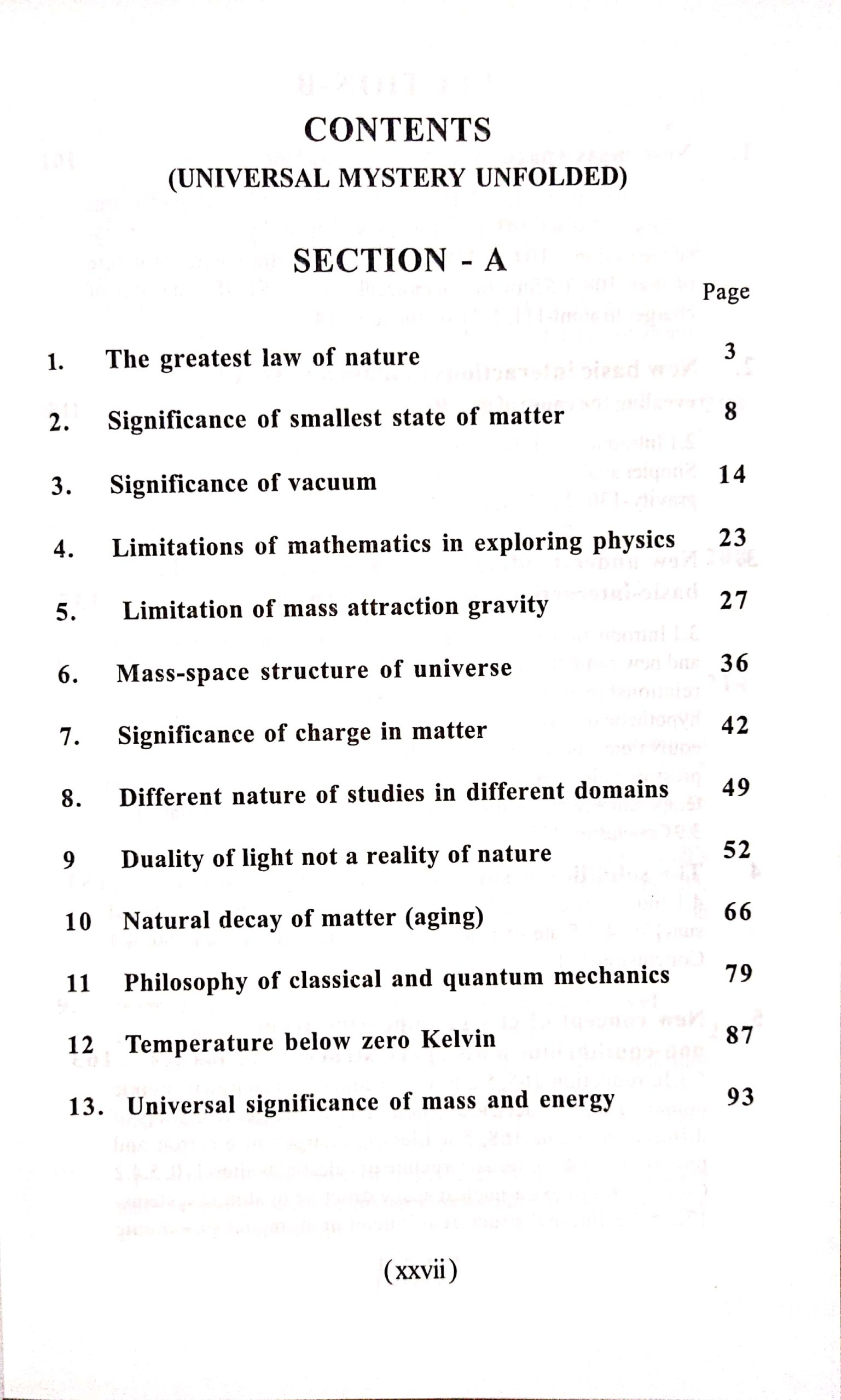
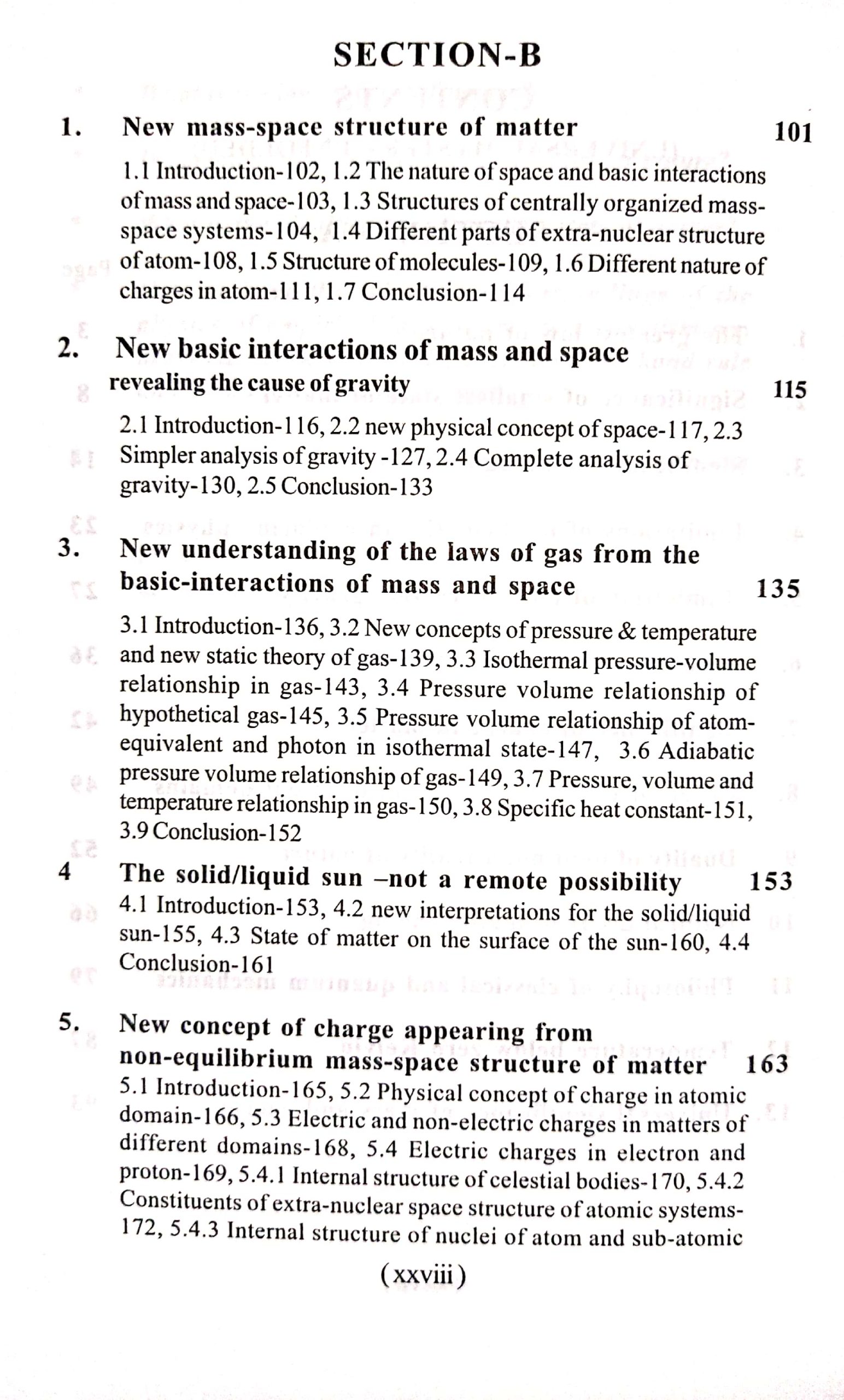
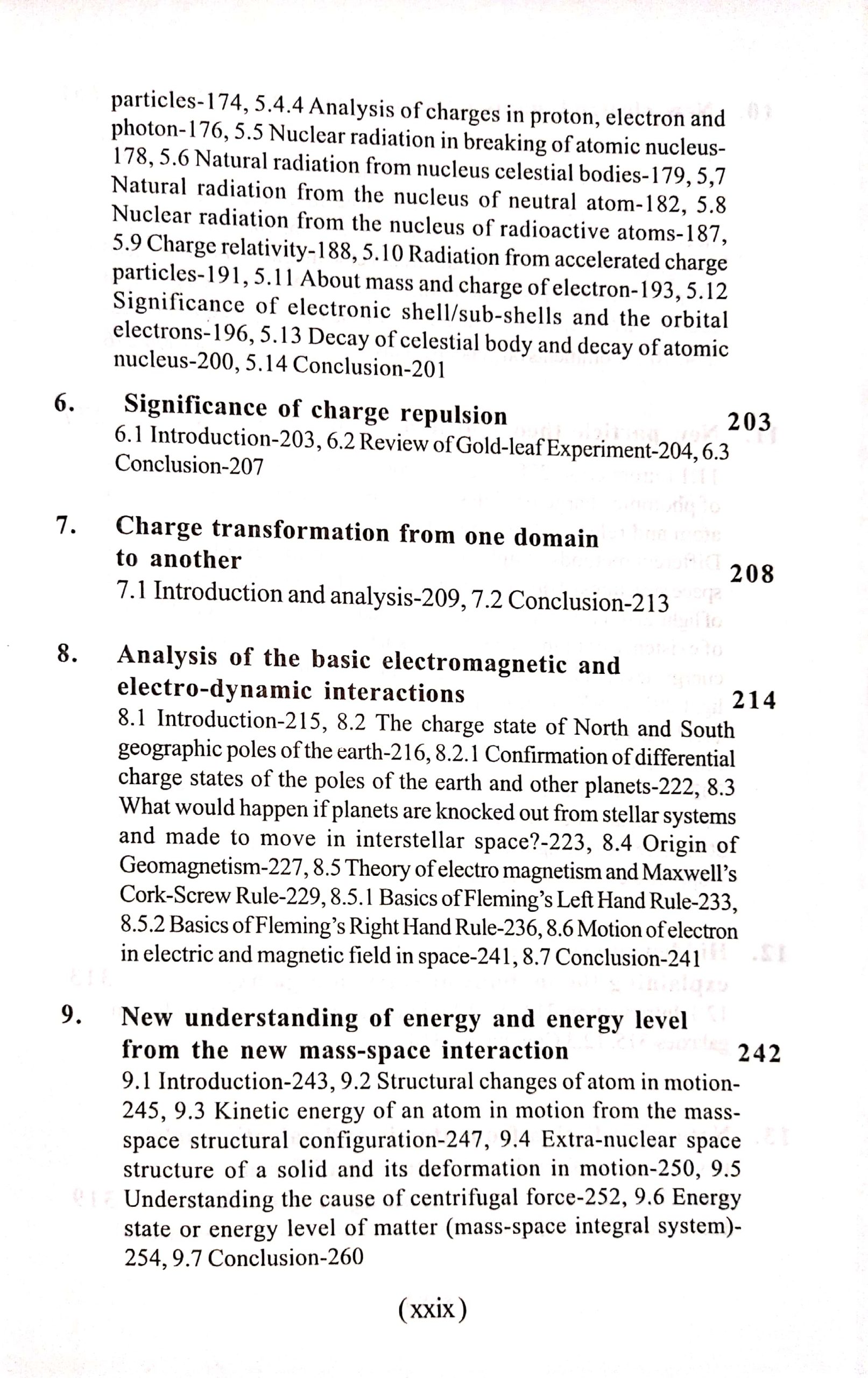

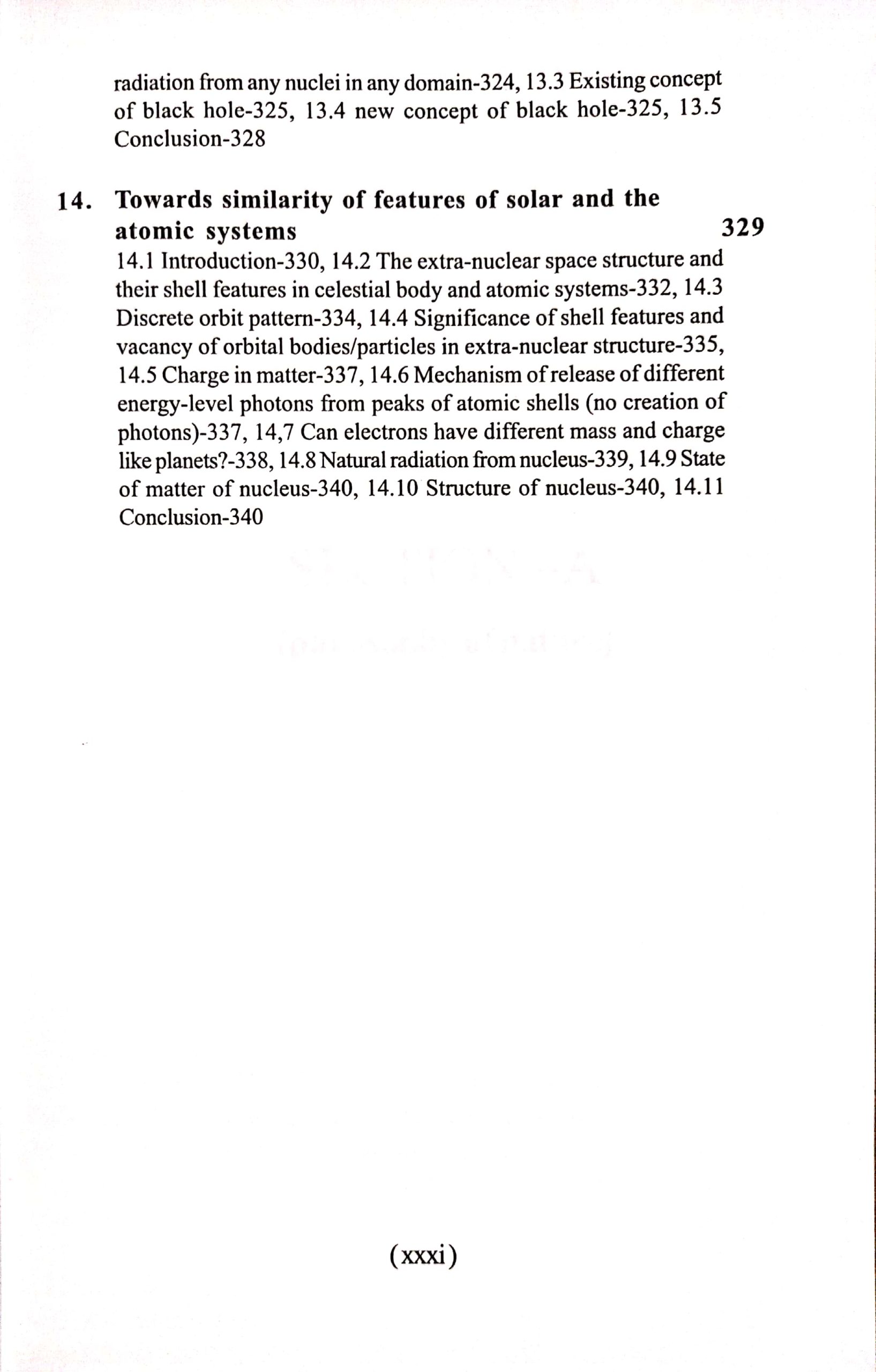
VOLUME – THREE
UNIVERSAL MYSTERY UNFOLDED
(Physical nature of space and
new mass-space interactions)
Our existing concept of space is relational where space exists in relation to matter. In this concept, if matter does not exist, then space also does not exist. Obviously space has no independent existence, hence it is not considered as a physical entity. Due to relational nature of space, geometry fully represents space. Today we consider space and time together as a four-dimensional geometry which still carries the relational concept of space.
Many phenomena of nature involving space such as propagation of waves in space, polarization of vacuum space, energy aspects of space, assumptions of string theory in space etc. appear feasible, only if, space renders some physical properties. A relational space cannot render physical properties. In view of the above physical properties of space, this author considers space itself to be a physical entity of nature. Thus, we have now two physical entities of nature viz. mass and space which are present in all systems and in all domains of the universe. It becomes obvious that, the universal laws of nature are the outcome of different interactions of mass and space. Only three types of basic interactions are feasible in mass and space viz. mass space interaction, mass-mass interaction and space-space interaction. The exact nature of interactions can be depicted from observation to systems in macro domain. The fact that every celestial body is associated with a space structure (atmosphere) and the space structure contains different space matter particles clearly reveals that the mass-space interaction is attraction. Again we notice the space around the celestial body does not get settled to the surface of the celestial body despite mass-space attraction. This further reveals the space-space repulsion. A kind of space density graded structure surrounding every dense mass is inevitable due to mass-space attraction and space-space repulsion. Thus, matter at any stage is a mass-space integral system. While trying to understand the nature of mass-mass interaction we find dense mass nuclei without extra-nuclear space structure are repelled from the massive sun which forms the solar wind and again, contrary to this, the universal law of gravity considers mass-mass interaction as attraction. Hence it appears difficult to conclude the nature of mass-mass interaction.
There is, however, a difference in the concept of matter in relational space and that in physical space. In relational concept of space, matter has one component i.e. mass; hence, Newton had to accept mass-mass attraction to explain gravity. But in new .physical concept of space, all forms of matter are mass-space integral systems. Therefore in the new physical concept of space, one sees three types of interactions among matters (mass-space attraction, space-space repulsion, and mass-mass repulsion) among interacting matters. A stronger mass-space attraction can accommodate mass-mass repulsion while producing a net attraction among matters (gravity). Thus the mass-mass repulsion satisfies the phenomenon of solar wind and other radiations from celestial bodies as well as gravity. Hence, the mass-mass interaction is repulsion.
The author emphatically concludes that, the space of nature is physical and there exist three basic interactions in mass and space (mass-space attraction, space-space repulsion and mass-mass repulsion)
A single change in the basic concept of space is capable of unfolding the mysteries of mass-space universe. Any existence in the universe in any domain is simply a mass-space integral system and the basic mass-space laws works uniformly in all domains of nature. We need not have to assume any special norms in any domain of nature and, therefore, need not face any limitation of laws of nature. The basic universal law does not fail anywhere nor requires special protection.
If the above mass-space interactions are basic then they must ex plain the electric charge interactions and the charge state of matter
(xxiii)
23
can be understood from typical mass-space structure of matter differing from that of neutral matter. The nuclei of atoms in a given background condition (frame of reference) associate mass-proportionate-space-holding surrounding the nuclei, where they are in equilibrium. In the state of equilibrium, the atoms behave mutually neutral to one another, giving rise to the concept of neutral atom on the surface of the earth. If the equilibrium space holding of any one atom is somehow partly removed then the atom with non-equilibrium space holding becomes reactive to acquire space from its surrounding matters. Such a non-equilibrium mass-space structure of an atom is a cat-ion. On the other hand, if the said atom somehow acquires more space holding than that of the neutral atom, then it is an anion. The vigorous reaction between cat-ion and anion is a charge interaction. This is the broad concept of electric charge and charge interaction. The details of electric charge are discussed in the book. This physical concept of electric charge has been extended to matters of other domains to understand other non-electric charges (photonic charge, celestial charge etc.) in particles/bodies of other domains. We do not find self existence of charge alone without matter. This is also found true for energy of radiation range of particles (photons etc.) in the new concept.
In the present concept, we assume that many mass-less particles have energy. Strictly speaking, it is not correct but in a different con text the mass-less concept may be accepted. For example, while dealing with the dynamics of celestial bodies the impact of atomic particles on celestial bodies may be neglected as well as atoms may be assumed mass-less. But in micro domain analysis atoms have prominent mass where the mass of photons and some other particles are insignificant and they may be considered mass-less. Likewise the mass-less particles of micro domain have prominent mass in micro-micro domain analysis. Thus in stellar domain physics the star systems have nucleus and extra-nuclear space structure, in atomic domain the atomic system has nucleus and extra-nuclear space structure and in photonic domain, the photon system has distinct nucleus and an extra-nuclear space structure. Again in the existing science, the light particles (photons) have no rest existence. During the time of Dalton, the electrons did not have rest existence because the atomic model has no provision for placement of electron. No doubt, the light particles and similar nomads will have rest life with their placement in new atomic model.
The state properties of matter such as charge potential, temperature, pressure, velocity etc. have been interpreted through the mass-space structure of different particles. The charge potential has been interpreted as the degree of non-equilibrium of mass-space structure in atomic and subatomic range of particles. Temperature (thermal/pho tonic charge potential) has been interpreted as the degree of non equilibrium mass-space structure in photons. Pressure is the force per unit area exerted by effect of space-space repulsion. More is the space density (space content per unit volume) more is the repulsion, hence more is the pressure. The associated extra-nuclear space structure of any nucleus deforms elastically in the state of motion relative to the medium. The degree of deformation is a function of relative velocity. This allows us to understand the equation of special relativity while the mass remains invariant unlike the relativistic mass. A matter possesses energy by virtue of any of the state property and the mass. In nuclear reaction, the dense mass of nucleus is fragmented where a part of mass is lost by disintegration to radiation range of particles (photons). In the present concept, photons being considered mass-less particles, it is presumed that mass converts to energy.
To pursue commonsense based knowledge for understanding micro domain physics is unthinkable in present time. This was considered pertinent during medieval period of science. According to modern science the physics of macro and micro domains stands on different footings having no similarity. But according to this author, it is only our modern science that has introduced different dynamics for different domains whereas such a difference does not exist in nature.
Based on the new concept of space and the mass-space interactions, the author of this book has dealt with different topics of physics, in a simple and clear manner, without entertaining exceptions, limitations, duality, or any other peculiarity in our understanding of nature. Thus it is not necessary to keep away our commonsense knowledge for understanding the physics of micro domain. We can understand the features and dynamics of any particle in any domain by applying our commonsense.
We may find that, our existing science has many limitations in understanding nature. Science is only capable of explaining how things hap pen but is silent about why things happen? We fail to achieve complete unification of fundamental forces of nature. We also accept many peculiarities such as propagation of wave without medium, unusual assumptions in atomic model and in Special Relativity. We are unable to resolve these problems and simplify science. Perhaps it is not a healthy sign for science to accept some facts as ‘beyond science’. The fact that the problems remain unsolved, points to some mistake in our fundamental concept, which is being carried forward without correction and prevents our further understanding. This author identifies the misconception of space which helps in furthering the scope of science.
B.C. Mohanty
UNIVERSAL MYSTERY UNFOLDED- Volume-III -has answers to the following questions
◼ Can we understand the physics of macro and micro domains through a unified dynamics?
◼ Is it possible to find the common cause of the forces of nature operating in different domains and unify the fundamental forces of nature?
◼ Can we pursue commonsense based knowledge to understand micro domain physics?
◼ Can mass and charge be uniformly present in matters of all domains?
◼ Can we have a uniform understanding of energy and energy level in micro and macro domain particles/ bodies?
◼ Is it possible to understand the equation, E=mc2, from macro concept of energy?
◼ Is the atomic system similar to the solar system?
◼ Can we understand exact electrodynamics without assorting to relativistic increase of mass?
◼ If the electric charges are of different types, then how do they respond to algebraic addition?
◼ The very fact that charge responds to algebraic addition implies that the negative and positive charges are of one type and we also find the charge activity in a charge potential difference, but then how is it possible that charged bodies at same potential (without a differential) repel one another?
◼ How can we say the light particles are neutral particles by knowing only that they do not carry electric charge (as they might be carrying non electric charge)?
◼ Is it possible, the sun to be in solid/liquid state for better understanding of solar-flares and other features despite high temperature?
◼ Can we understand the laws of gas from the property of molecules without the statistical kinetic theory of gas?
◼ Can we understand a slow gradual natural decay of atomic nucleus similar to the decay of celestial bodies?
◼ Can the structural features of nucleus of atom be similar to that of celestial bodies?
◼ Is it possible to remove duality from the theory of light?
◼ Is it possible to understand the dynamics of stars in a galaxy without introducing the concept of dark matter at the boundary of the galaxy?
◼ Can we understand the structure of black holes? * Is there a physical significance of electric charge?
◼ Can we afford to vary the mass and charge of electrons?
◼ Does temperature lower than 0 Kelvin exists?
◼ Can we expect classical mechanics in atomic system and quantum mechanics in stellar system?
◼ What is the physical significance of vacuum?
◼ What is the law of laws of nature?
◼ Is commonsense different from the laws of nature? * What is the significance of smallest state of matter?
◼ Can we have the scientific understandings of the physics of empirical laws of electro-magnetism e.g. Maxwell’s cork screw rule, Fleming’s left hand rule and Fleming’s right hand rule?
◼ Can we understand the smallest magnetic domain and the magnetic monopole?
◼ Perhaps these and many more questions can be answered.
Read our Journal 'Towards Unification of Sciences'
The journal publishes brainstorming articles on new and break through ideas, concepts and theories.
